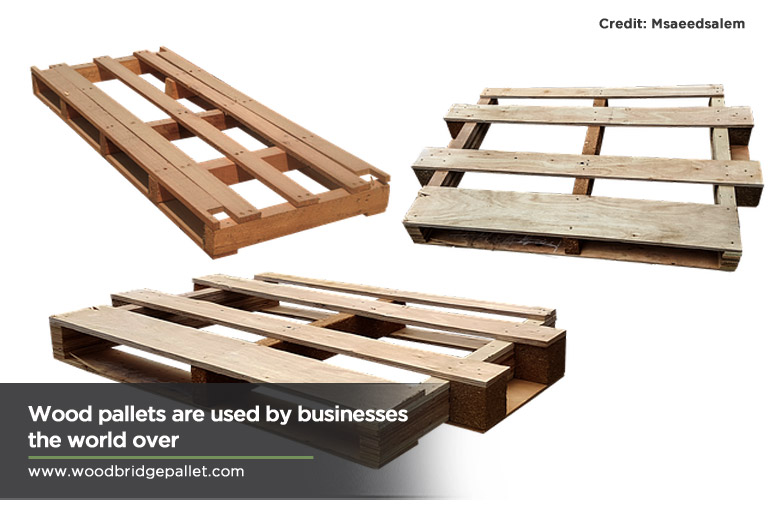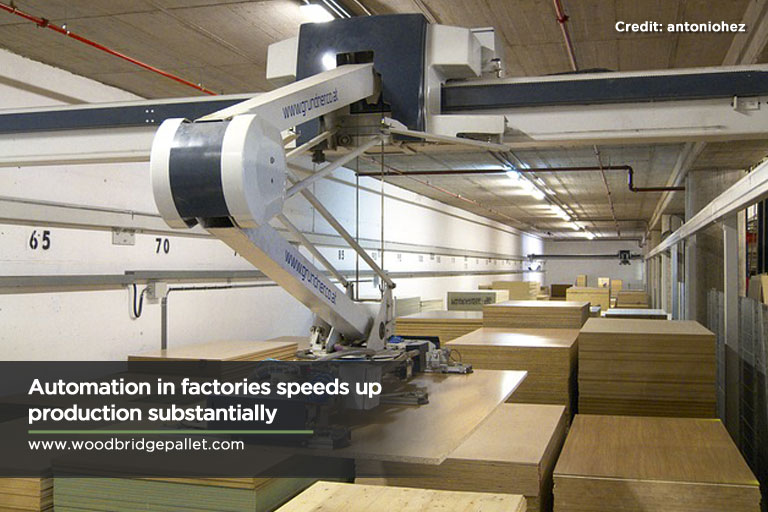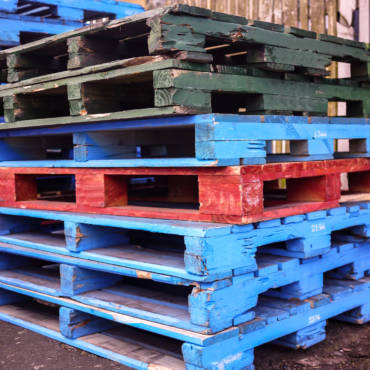Robotics and automation play an increasingly important role in the manufacturing process. They are used to carry out the repetitive tasks that many people would rather not do, which opens up the possibility for higher level jobs within an organization. More and more companies are currently using robots for palletizing. This meeting between automation and pallets has greatly affected quality and cost.

Pallet History
The invention of pallets occurred sometime in the 1920s and has had a massive impact on the world economy. Suddenly, it was much simpler to package and ship large quantities of goods. Not surprisingly, the forklift was invented around the same time; it was finally possible to lift and move these loaded pallets without difficulty.
Importance to the Economy
Pallets may look relatively simple, but they play an essential role in the economy. Around the start of the 20th century, companies worldwide began to use pallets for shipping, storing, and displaying their products.
Currently, in North America alone, there are 450 million pallets produced every year. Modern pallets are usually made of wood, but some are made of plastic, metal, paper, or recycled aluminum.

How Pallets Are Priced
There are several key factors that contribute to the final cost of a pallet. The two main determiners are labour costs and raw materials (like lumber and nails). Some aspects of lumber pricing, such as changing conditions in the hardwood and softwood industries, are out of anyone’s control. While manufacturers are free to buy either type, costs will vary based on market activity at the time of purchase.

The cost of lumber can also fluctuate based on wood quality, grade, year of purchase, and the season. For example, the price of softwood lumber tends to go up around March and April because production in mills slows down at that time of year. The price of hardwood lumber remains a lot more stable; when it does increase, it tends to surge.

Robotics/Automation in Industry
In today’s world, it’s not unusual to see a company turn over the majority of its manufacturing to robots and automated machines. Robots have numerous applications that impact the cost and quality of both the merchandise and the pallets used in delivery.
Robots are extremely efficient. They can perform the same repetitive action at the same pace (or faster) than human beings, and they’re highly accurate. Some robots can work at varied orientations if it’s necessary. They can also be hooked up to computers and given precise instructions. Robots in manufacturing carry out many jobs, including transportation, welding, painting, assembly, picking and placing products, packaging and palletizing, product inspection, and testing.
The type of industries that incorporate robots have changed in the last 10 to 15 years. In 2002, automotive companies used 90% of the robots made. Today, however, 90% of robots are purchased for other industries and can be found in hospitals, energy plants, and even farms.
Palletizing Robots
In the 1950s, factories started using mechanical palletizers in production, as opposed to doing it manually. This sped up the production process considerably and lowered operational costs. However, these mechanical palletizers had one big fault—all the products had to be exactly the same size. This type of effort succeeded when things were packed and shipped in bulk, but it was clear that mechanical palletizers weren’t going to last particularly long.
The first industrial robot, “Unimate,” was introduced to the public in 1961. Only two years later, robots entered the manufacturing process with the introduction of the first palletizing robot invented by Fuji Yusoki Kogyo. These early models were huge, industrial robots that already had advantages over human beings:
- They generally took up less room.
- They could be reprogrammed.
- They could do mixed-case palletizing.
- They were capable of handling several different products at the same time without becoming confused.
When collaborative robots were invented, another massive shift occurred in the manufacturing process. Robots were now accessible to any size business and began to replace human beings in industries the world over. However, this trend led to the creation of better, more challenging jobs for people.

The process of replacing workers with palletizing robots saves a tremendous amount of money in labour and operational costs. Robots are extremely precise and capable of performing the same action over and over again without error. They don’t need sick days or vacation days, and they don’t take breaks or sleep. Using robots has decreased the margin of error a great deal. In today’s landscape, human beings on the factory floor are considered a liability. Supply chain consultant Tony Vercillo says, “The trick to warehousing is eliminating human touches. Every time a human touches a pallet or a case, an expense occurs. Technology should be used to reduce the number of touches and steps within the warehouse process.”
This massive reduction in operational and labour costs has driven down pallet prices. Although there are other factors that also impact prices, the cost of pallets has dropped in the age of robotics and automation.
Robotics/Automation and Pallet Quality
Robots, in general, can improve the overall quality of pallets. Their work is always the same and consistent. They can also perform routine tasks again and again without getting tired or bored. The margin of error for robots is much lower too, since humans can’t perform at the same level of efficiency without food or rest.
The age of robotics and the automation of the manufacturing process have had a positive effect on both the quality and price of pallets. The fact that robots are much quicker, more accurate, and more efficient than humans means faster and higher production quality overall. Automation saves money on both operations and labour costs, while driving down the cost of pallets as well.
At Woodbridge Pallet Ltd., we produce and repair more than 15,000 pallets every day, and we do it using a very modern and efficient manufacturing process. We’re proud to provide our clients with well-designed, quality wood pallets. Give us a call at (905) 856-3332 to discuss your pallet requirements. We’d be happy to help you.





